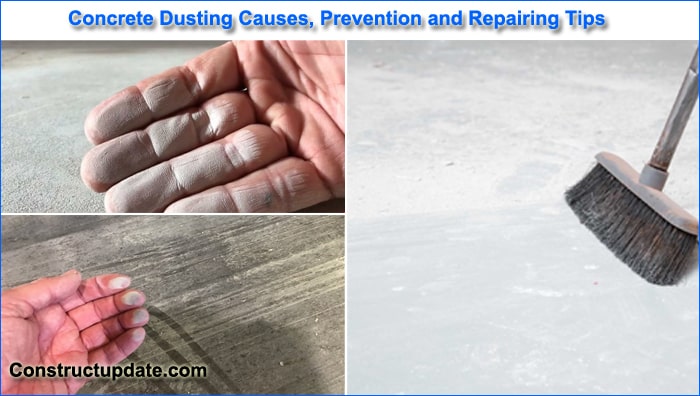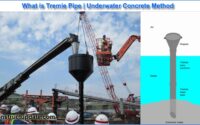Concrete Dusting Causes | Concrete Dusting Prevention and Repair Tips
The development of fine, loose powdered material that can be easily swept away on the surface of hardened concrete is known as dusting, sometimes known as chalking. Although dusting is a common occurrence both inside and outside of buildings, it is more hazardous when it occurs inside.
Laitance, a thin, brittle layer of a concrete surface made of water, cement, and small particles, is the cause of dusting. Therefore, any component that weakens concrete, especially the top layer, raises the chance of dusting. For instance, finishing concrete while it is still bleeding, pouring concrete on surfaces that are not absorbent, improper curing, etc.
By creating a robust, wear-resistant concrete surface, dusting the concrete surface can be avoided. This can be accomplished by following the right curing procedures, refraining from premature finishing, utilising a low water-cement ratio, and staying away from the addition of dry cement and water to speed up finishing.

What are the Causes of Concrete Dusting
The wear of a porous surface and incorrect matrix-fine aggregate bonding result in dusting. These are the causes:
Adding More Water to Concrete Mix
Adding more water than is necessary to the mixture enhances bleeding, which causes water and particles to float to the surface. Consequently, the surface has minimal wear resistance.
Unskilled Finishing
Making the water return to the concrete’s surface by performing the finishing operation while bleed water is on the surface. It results in a low-strength surface layer and a very high water-cement ratio.
Inadequate curing
When concrete is properly cured and allowed to dry quickly, especially during the hot, dry, and windy seasons, the surface layer will be weaker as a result. Even when walked on, they might still have dust in them.
Poor Surface Compaction
Poor surface compaction and finishing lead to a reduction in abrasion resistance.
Use of Dry Cement
Dry cement is used for soaking the surface water in order to permit the earlier finishing. This causes the surface layer to become weaker by increasing the amount of fine material there.
Freezing the surface
The expansion of the water causes the concrete mixture to be disrupted, causing the surface to freeze early than necessary to build strength, resulting in a weak layer.
No proper ventilation in enclosed place
Carbon dioxide emitted by salamanders, gasoline engines, generators, or mixer engines can cause a carbonation reaction, which can significantly degrade the strength and hardness of the concrete surface.
Rainwater
The same effects as premature finishing will occur if precipitation penetrates the surface before the concrete has reached its final setting.
Tips to Prevent Concrete Dusting
- The right mix design, the right concrete material selection, and the right building techniques are used to provide the requisite slump, strength, and durability requirements while avoiding excessive bleeding, segregation, or bleeding.
- Never trowel dry cement or sprinkle it on top of plastic concrete to soak up bleed water. Drag a garden hose across the area to remove bleed water. Modifying the mix proportions can reduce excessive concrete bleeding.
- Offer appropriate curing. Often, little or no curing of the concrete surface leaves it with a soft surface that quickly dusts under traffic.
In hot climates, proper curing is crucial since the conditions frequently favor quick loss of moisture from the surface. One technique that is frequently used for slabs to lower temperature build-up is to cover the surface with wet hessian. An alternative is to apply a curing product to prevent the concrete from drying up before it reaches the ultimate setting point. As soon as the concrete reaches its final set, wet curing should begin using bunds, hessian cloth, or sprinkler arrangements. Work in hot, dry circumstances for at least 10 days during wet curing.
Tips to Repair Dusting Concrete
There are several ways to deal with this issue. The first is to remove this thin layer using a grinder or shot blaster to reveal the sturdy concrete underlying and perhaps a brand-new surface with excellent wear resistance. One more approach is to use a surface hardener. This treatment won’t make a concrete slab that is already subpar into something better, but it will increase wearability and lessen surface dusting.
Many floor-surface hardeners contain sodium silicate (water glass) or a metallic silicofluoride as their main component (magnesium and zinc fluosilicates are widely used). Typically, the treatment is given in two or three coats, allowing the surface to dry in between. Painting concrete surfaces with acrylic, urethane, or epoxy is another option.
What are the Health Risks of Concrete Dusting
Sand and gravel that are “free” of crystalline silica are used to make concrete and concrete blocks. Surface abrasion removes tiny crystalline silica particles, which are then released into the air we breathe. The three types of silica are quartz, cristobalite, and tridymite, with quartz being the most prevalent. Silica dust is also released by stucco and mortar.
Other dangerous ingredients included in many types of cement include compounds of lime, nickel, cobalt, and chromium. Human tissues are corroded by alkaline compounds, and chromium in trace amounts can trigger allergic reactions.





